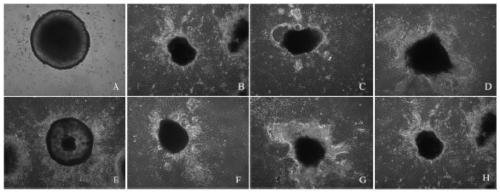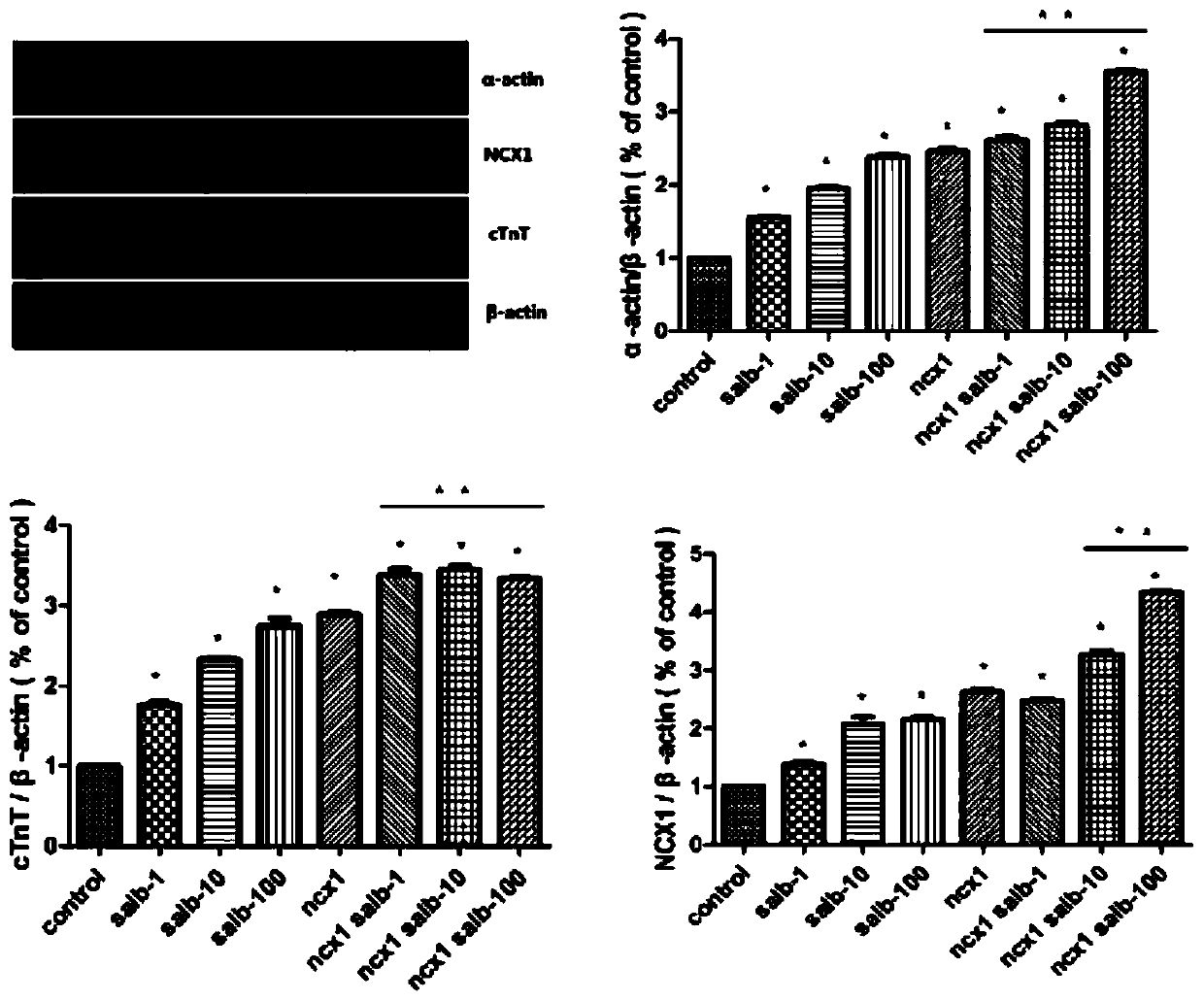The method of sodium-calcium exchanger 1 promoter combined with salvianolic acid b to induce directional myocardial differentiation of iPSCs
A technology of salvianolic acid and sodium-calcium exchange, applied in the field of medicine, can solve the problems of a wide range of myocardial necrosis, the failure of clinical application to be widely carried out, ischemia and hypoxia in the local myocardial microenvironment, and achieve the effect of broad application prospects
- Summary
- Abstract
- Description
- Claims
- Application Information
AI Technical Summary
Problems solved by technology
Method used
Image
Examples
Embodiment 1
[0021] Example 1 Preparation of iPSCs
[0022] 1) Preparation of trophoblast layer (MEF): Add 0.1% (volume fraction) gelatin into a T25 culture flask, put it in a cell culture incubator at 37°C for 20 minutes, then suck it off, add 5-6 mL of MEF culture medium preheated at 37°C At the same time, the mouse embryonic fibroblasts (MEF) (purchased from the cell bank of the Chinese Academy of Sciences in Shanghai) were quickly taken out from the liquid nitrogen, placed in a 37°C water bath to melt quickly, and immediately wiped and frozen with 75% alcohol by volume fraction Transfer the cell suspension in the cryopreservation tube to a 15mL centrifuge tube containing MEF culture medium, centrifuge at 1000rpm for 5min, discard the supernatant and resuspend it, add it to a T25 culture bottle, and place it in a CO 2 In a constant temperature incubator, iPSCs can be added to the feeder layer after 24 hours of culture;
[0023] 2) Cultivation and passage of iPSCs: The trophoblast obtai...
Embodiment 2
[0024] Example 2 Preparation of Sodium Calcium Exchanger 1 Promoter
[0025] 1) Construction and identification of lentivirus Neo-Promoter_419bp>Luciferase:IRES:DsRed_Express2:
[0026] Primer design: According to the cDNA sequence of the sodium-calcium exchanger 1 promoter gene in Genebank, the primer sequence of the sodium-calcium exchanger 1 promoter was designed as follows:
[0027] Upstream primer: 5′-GCAACAGACATACAAACTAAAGAAT-3′;
[0028] Downstream primer: 5'-GGAGCAACATAGTTAAGAATACC-3'.
[0029] PCR amplification: under the action of the above primers, the cDNA of the sodium-calcium exchanger 1 promoter was used as a template for amplification, the PCR product was detected by electrophoresis, and the target band was recovered and purified by gel cutting. Recombine the vector Neo-Promoter_419bp>Luciferase:IRES:DsRed_Express2 with the amplified sodium-calcium exchanger 1 promoter under the action of endonuclease, take 2 μL of the recombination reaction solution to trans...
Embodiment 3
[0035] Example 3 Cell immunofluorescence and morphological identification
[0036] After induction culture for 20 days, wash with PBS 3 times, fix with 4% paraformaldehyde, wash with PBS, counterstain cell nuclei with DAPI for 10 min, and fix with resin glue. Observe under a fluorescence microscope and an inverted microscope, and observe 10 fields of view in each well, a total of 30 fields of view.
[0037] NCX1 expression after NCX1 lentivirus transfection induced pluripotent stem cells, such as figure 1 shown. The results showed that NCX1 was effectively expressed in iPSCs through qualitative analysis by fluorescence microscopy.
[0038] Sodium-calcium exchanger 1 promoter combined with salvianolic acid B induced morphological changes of iPSCs after differentiation, such as figure 2 shown; among them, A: control group; B: salvianolic acid B (1 μM); C: salvianolic acid B (10 μM); D: salvianolic acid B (100 μM); E: NCX1 group; F: NCX1 + salvianol Acid B (1 μM); G: NCX1 + ...
PUM
 Login to View More
Login to View More Abstract
Description
Claims
Application Information
 Login to View More
Login to View More - R&D
- Intellectual Property
- Life Sciences
- Materials
- Tech Scout
- Unparalleled Data Quality
- Higher Quality Content
- 60% Fewer Hallucinations
Browse by: Latest US Patents, China's latest patents, Technical Efficacy Thesaurus, Application Domain, Technology Topic, Popular Technical Reports.
© 2025 PatSnap. All rights reserved.Legal|Privacy policy|Modern Slavery Act Transparency Statement|Sitemap|About US| Contact US: help@patsnap.com



